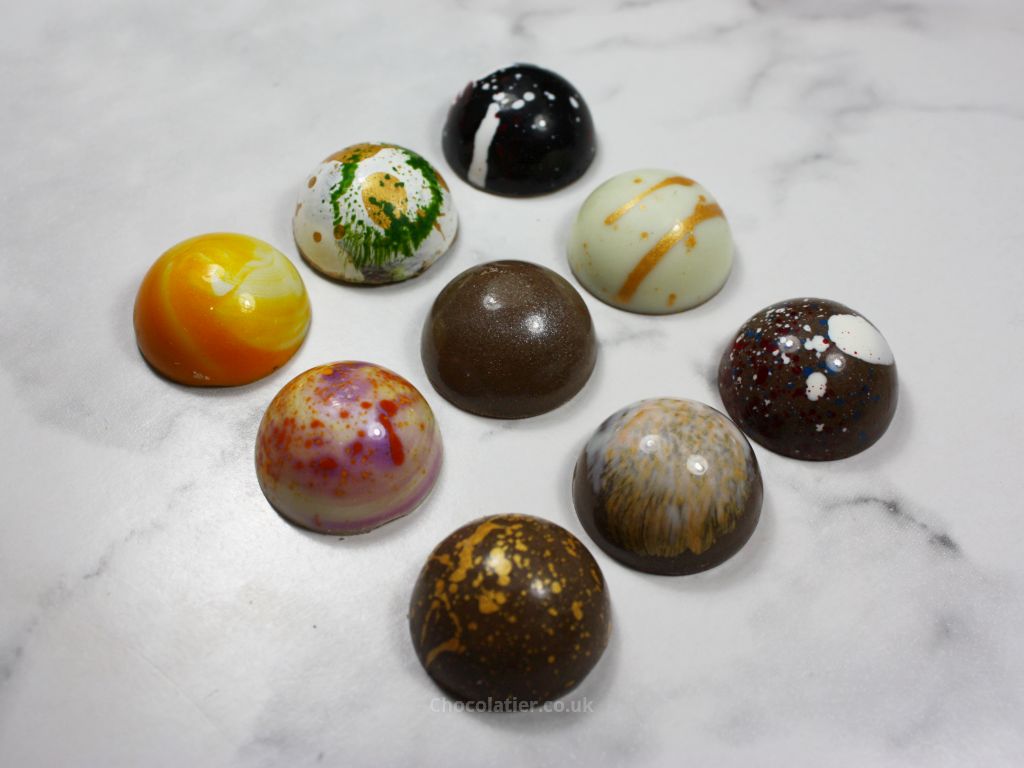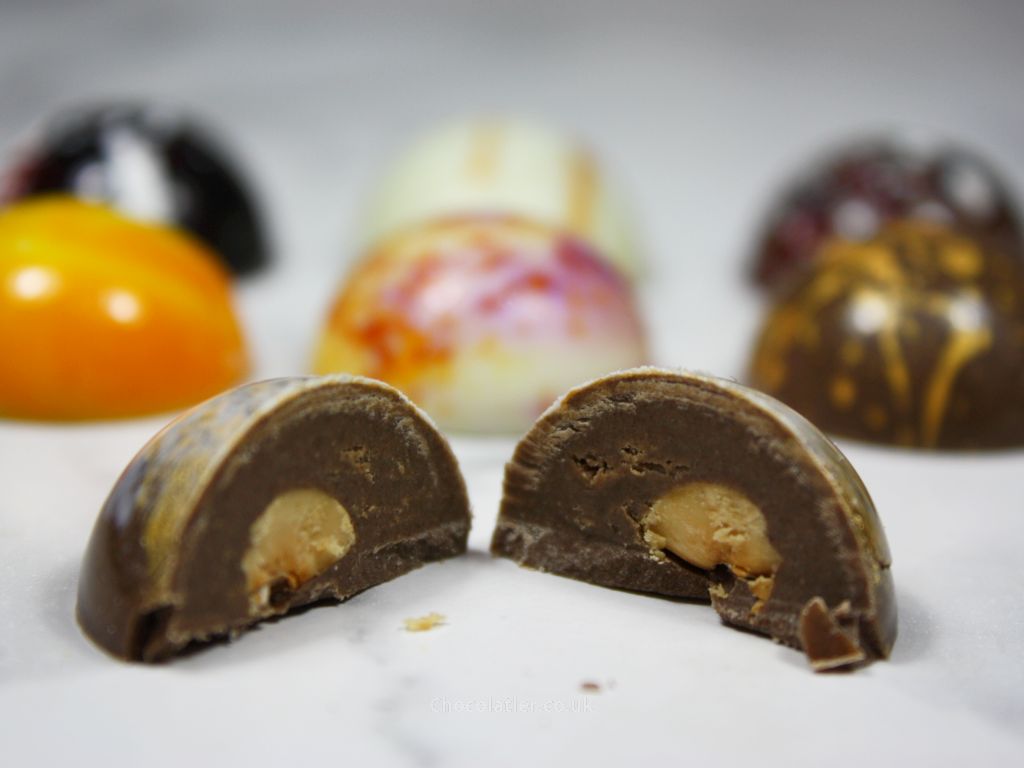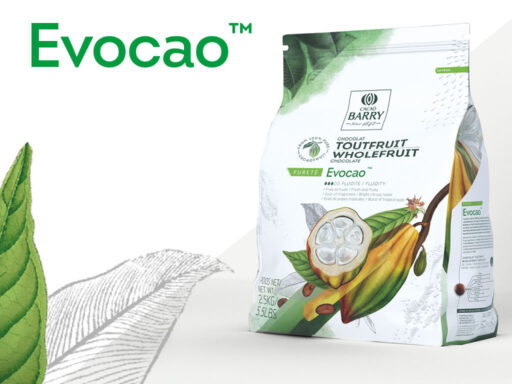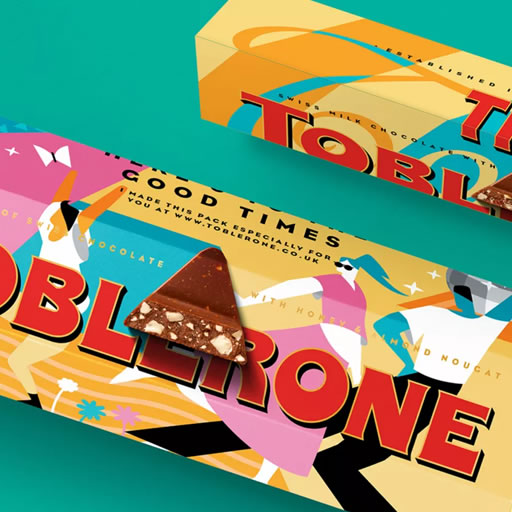In this article:
We're used to hearing about lab-grown meat. This synthetic meat promises to solve the problem of feeding the world's growing population while being more sustainable and more ethical. Whether humans will accept such a product as part of their normal diets is yet to be seen.
Now, scientists have turned their sights to chocolate, creating a cocoa-free product that is indistinguishable to the flavour of chocolate in taste tests.
But is synthetic chocolate (mock-chocolate or mockolate perhaps?) the answer to unsustainable business practices that have plagued the cocoa industry for decades, or does it simply shift unsustainable practices from one sector to another?
I chatted to Stefan Kullack, Operations Manager at Munich-based cleantech startup, QOA, to find out more about their latest innovation. Then, in a timely bit of luck, I won a competition to become an official taste tester, working my way through a box alongside 315 fellow testers. Come with me as I take a bite out of the future.
UPDATE: QOA, the company, has rebranded to Planet A Foods and QOA, the cocoa-free 'chocolate' product, is now known as Nocoa.
What is QOA?
Let's start at the beginning. What is QOA? It's the brand name of the company that has developed cocoa-free 'chocolate'.
Eagle-eyed readers will spot the contradiction here. The EU legally defines chocolate as a product derived from at least 35% cocoa solids, at least 18% cocoa butter and at least 14% dry non-fat cocoa solids, with variances for vermicelli, flakes, couverture, and gianduja. So, by definition, cocoa-free QOA cannot be called chocolate, even though it supposedly tastes like chocolate and is designed to be used as a chocolate substitute.

Definition aside, it's a groundbreaking development. The closest we've gotten to creating a cocoa-free chocolate flavoured product is carob, and that has its drawbacks. Carob, native to the Mediterranean region and the Middle East, is a flowering evergreen tree and its dark brown pods can be used to make a vaguely chocolate-like substance. It's a fibrous substance, low in fat and sugar and rich in antioxidants. While it's the go-to replacement for many who can't enjoy munching on chocolate, the flavour isn't a perfect match.
The team at QOA reckon their new product nails the chocolate flavour, and it has been through rounds of taste testing to prove this in focus groups. Anecdotes document the journey from concept to prototype, with mixed results until the point the team hit upon a viable product.
QOA's vision is to create an eco-friendly, cheaper and healthier alternative to traditional chocolate, made available to the masses.
How did they Discover QOA?
According to co-founder Sara Marquart, the company analysed the 'fingerprint' of cacao throughout the various stages of chocolate production, to unlock its flavour secrets. She likens the production of QOA to that of beer.
In an interview with Germany's Clean Thinking, Marquart recounts setting up seven Thermomix devices in brother and fellow co-founder Dr. Maximilian Marquart's kitchen to begin the scientific investigations.
The team then set about creating a process (termed precision fermentation) to program microorganisms to produce organic molecules of any type or complexity. After fermentation, the final product can be roasted and dried - like traditional cocoa - and used in production.
What Ingredients are in QOA?
That's not been fully disclosed yet, although details will have to be released when this product heads to market.
Kullack explained that the product is based around fermenting by-products from the food industry, such as nuts, seeds, and grains. QOA has found a way to upcycle industrial food waste, fermenting it to form a new cocoa-free chocolate flavour product. In an age when we should all be looking to minimise food waste (and waste in general), I like this concept.
Triple Pundit reported that one scientist claimed yeast was involved.
QOA's Research and Development team told me "our product is 100% natural, sustainably farmed, and [it takes] about 24-72 hrs [to] process from raw materials to finished product."
As a side note, the fact that nuts and grains are used in the fermentation process suggests that QOA will not be suitable for those with nut and grain allergies, which is a bit of a shame.
Part of my tasting questionnaire asked for feedback on naming conventions, asking for suggestions on how best to describe fermented tree nuts (apricot kernels), hardened vegetable oils, and cereals (oats). I suspect these are core ingredients in QOA.
Which Applications Can QOA Replace Chocolate?
Based on the Supermassive testing kit, QOA comes in formats similar to white chocolate ("white QOA"), milk chocolate ("milk QOA"), and dark chocolate ("dark or semi-dark QOA").
QOA claims its product is "10x more sustainable and 20% cheaper than conventional chocolate." I suspect mass-manufacturing businesses will latch onto the 20% reduction in costs as a key motivator to experiment with QOA in their product development.
That's where I see QOA most used. During product development, QOA produced "Supermassive Test Kits" featuring pretty-looking chocolate bonbons. While I see a small market for these, I think QOA would be best used as a chocolate substitute. Aside from chocolate bloggers, I'm not sure many would willingly trade in their favourite brand of chocolate for a bar of delicious chocolate substitute, no matter how good it tastes. It would be an uphill struggle trying to convince people of the merits.

Yet, replace the chocolate coating of an ice cream bar with QOA, or replace the chocolate coating on a wafer snack bar and I don't think many consumers would swerve from it. You're still buying a [insert brand of chocolate snack here], it's just more sustainable and environmentally conscious. That's a win-win in many consumers' eyes.
QOA seeks to make its sustainable product the norm by 2035. It revealed in an interview with Fast Company that it envisions a future where all the cocoa used in mass market products is replaced with QOA.
Is QOA Sustainable?
Good question. At first glance, I'd say yes. It repurposes food waste that would otherwise head to landfill, so it's not reliant upon virgin material. Plus, QOA's Research and Development team told me their "product is 100% sustainably farmed."
Their tasting questionnaire also quizzed participants on sustainability, and the concept of upcycling food by-products, which will be a fundamental unique selling point for the brand.
However, we don't know the full set of ingredients yet, so it's hard to tell what crops it relies upon. Plus, as the product uses food waste, QOA is theoretically at the mercy of the companies producing the waste as to how and where the original ingredients are sourced. As such, we don't know the conditions on the ground, the environmental impact of the crop farming and its transportation, nor the price paid for crops, and its socioeconomic impact in farming communities.
So, on the face of it, it sounds like QOA is a truly sustainable and ethical product, but it's too early to know for sure.
Is QOA The Solution To The Chocolate Industry's Problems?
There are several problems that plague the chocolate industry. Deforestation by rogue or desperate farmers looking to maximise income is contributing to climate change. In turn, climate change and ecological changes are reducing crop yields on cacao farms, forcing the arms of many desperate farmers to seek alternative ways to survive.
The biggest issue blighting the chocolate industry, though, surely has to be the pittance that cacao farmers are paid for their crop, especially compared to the retail prices we pay in the shops. It traps farmers in poverty and incentivises modern slavery and child labour.
Cacao farmers are already on the brink, plunged ever deeper into poverty as demand for chocolate surges. Their struggles are documented in Kristy Leissle’s hard-hitting Cocoa Book. Only a tiny fraction of the price we pay for a chocolate bar in the supermarket makes its way back to the farmers. Yet, we rely on the farmers to feed our insatiable appetite for sweet chocolate.
QOA can certainly help with aspects such as deforestation. Food waste is plentiful, and doesn't require new swathes of virgin lush green rainforests to be cleared for vast fields of cacao trees. The original ingredients may or may not have contributed to deforestation though, so we need to see the ingredients list to fully understand the product's origins.
As for the economics, it depends on how successful QOA is, and the applications it is used in, as to whether cacao farmers need to fear this innovation. If the roll out is hugely successful, and QOA becomes the de facto standard for chocolate, it will significantly reduce the demand for cocoa, making it harder for farmers to economically survive tending cacao trees.
Cacao farmers rely on multinational corporations for their income, as The Telegraph's Andrew Baker quite rightly points out. Should they latch onto the profit margin potentials of QOA, and favour it over traditional chocolate, countless farmers across Africa and the Ivory Coast in particular will be hardest hit.
If QOA becomes a niche product, and is used in the same way that carob is, then I doubt there would be significant impact on the global demand for cocoa.
Does QOA Taste Good?
That's the million dollar question, isn't it? Until now, only the team at QOA and a handful of test subjects know that, but they seem confident that their product stands up against comparison with traditional chocolate.
In an article on Fast Company, Sara Marquart recounts one early version of the product that garnered feedback from one tester that she "had to brush her teeth three times" after eating it. However, after going back to the drawing board, the team developed a product that fooled chocolate sensory experts at research organisation Fraunhofer.
In late November 2021, QOA sent 316 test kits out to some of the 1,600 interested people on its newsletter list. Successful applicants agreed to complete a short survey while tasting, helping QOA with field research on this innovative cocoa-free chocolate concept.

I was one of the lucky 316. I received my test kit, packaged up in a large polystyrene padded box as if it were a precious scientific or medical package. Inside, a biodegradable resealable bag kept my box in place.
Sliding the outer cover off, I revealed a tray of nine smaller boxes, each codenamed with a letter and number. Each small box contained a quaint QOA bonbon, designed to look like a traditional European chocolate bonbon with a series of artistic patterns and designs.

I sampled each one and jotted down my thoughts, as follows.
- M60
- Flavour: It's described as a QOA, cashew and caramel filling, with a semi-dark QOA shell. The QOA filling takes up most of the room inside the shell, with a very fine layer of caramel resting on the top.
- Appearance and aroma: A beautifully glossy shine is exhibited my this chocolate dome, decorated with red and white splodges of colour. The dominant aroma is vanilla, with a nutty background fragrance. There's a heady sweetness in the mix too. It reminds me of the smell of chocolate pillow (or hoop) breakfast cereals.
- Taste: Texturally, it's crunchy and gritty, with a lot of sweetness and a helping of creaminess in the mix. In terms of flavour, notes of vanilla dominate, making way for subtle coffee and vegetal notes. The flavour of cashews is lost in translation. In the aftertaste, there's a sweet, creamy, vanilla flavour that lingers.
- Rating: 6 out of 10. It's alright, but not great. It lacks the enjoyment factor of chocolate, and its flavour. The vanilla notes dominate, as if to mask other flavours.
- M51
- Flavour: The description teases a QOA and almond crunch, with a semi-dark QOA base and a white QOA shell.
- Appearance and aroma: The white shell lacks the glossiness of M60, but I do like the splashes of gold decoration to mimic the dazzle. The dominant aroma is vanilla, with a nutty background fragrance. There's a heady sweetness in the mix too.
- Taste: This mirrors M60, with the same flavours and textures, albeit slightly sweeter and slightly creamier. Again, the subtle almond flavour is lost here. The key difference with M51 is a wave of negative flavour that rises and crests mid-way through the tasting. The flavour is difficult to describe other than it tasted artificial, bordering on medicinal.
- Rating: 3 out of 10. The wave of unpleasantness ruined this one for me.
- M84
- Flavour: Here we've got a peanut cream with QOA, inside a semi-dark QOA shell. The reality is a layer of QOA, with a peanut caramel layer on top.
- Appearance and aroma: Like M60, this one exhibits a beautifully shiny exterior, with a patchwork of red, white and blue dots. The dominant aroma is vanilla, with a nutty background fragrance. There's a heady sweetness in the mix too.
- Taste: This one starts off like a American-style peanut butter chocolate bonbon, with a rush of peanut flavour. Then, it makes a turn and that wave of negative flavour floods in, with an unpleasant characteristic that ruins it for me.
- Rating: 4 out of 10. The peanut flavour was good, but that chemical, almost-medicinal, flavour ruins it for me.
- M104
- Flavour: A semi-dark QOA base and dark QOA shell hides a filling of QOA with pumpkin seeds.
- Appearance and aroma: A layer of white, green and gold colour clads the surface of this bonbon, with a mild glossiness to boot. The dominant aroma is vanilla, with a nutty background fragrance. Interestingly, the fragrance is less intense on this one. Inside, the filling is a dark green, and there's a whole pumpkin seed at the base.
- Taste: Remember M60? This is exactly like that. The only differences are that the texture is finer (but still gritty) and that there is a subtle hint of pumpkin seed right at the very end of the tasting. The aftertaste is dominated by the sweet, creamy, vanilla, vegetal notes
- Rating: 6 out of 10. It's alright, but not great.
- M105
- Flavour: A semi-dark QOA shell, with a milk QOA filling.
- Appearance and aroma: The shell exhibits a nice gloss, enhanced by silver speckles. The familiar aroma of vanilla, with its nutty background fragrance, dominates once again. Inside, the filling is a smooth whitish-yellow paste.
- Taste: This is perhaps the smoothest out of the lot. It's also perhaps the sweetest of the lot. And the creamiest. But its greatest strength is just about managing to drown out the weird chemical flavour that comes through in the flavour of the earlier samples. To me, this tastes on a par with a budget white chocolate. That's by no means a criticism. Remember, QOA is not chocolate and has not seen a cocoa bean in its life, so to get close to the real deal is an achievement here.
- Rating: 7 out of 10. Good, but not perfect. There's a faint hint of the weird flavour that tries to develop, but the creamy filling bats it back down. Get rid of that and you could end up with the makings of a white chocolate substitute, in which snack manufacturers may see many possibilities.
- M106
- Flavour: A QOA and Piedmontese hazelnut filling with a semi-dark QOA base and dark QOA shell. Inside, a smooth paste surrounds a whole hazelnut.
- Appearance and aroma: The shell exhibits a nice gloss, finished with a white and orange pattern. The familiar aroma of vanilla, with its nutty background fragrance, dominates once again, albeit with a roasted hazelnut twist.
- Taste: I'm a fan of hazelnut chocolates. I'm particularly fond of Green Triangles in Quality Street tins, and of Gianduja. At home, I've blended hazelnut paste and chocolate to form my own recipe that combines the sweet creaminess of milk chocolate with the rich, roasted hazelnut flavours. Biting into M106 put a smile on my face. It's not a million miles away from the flavour of a Green Triangle. The rich, roasted hazelnut flavour dominates from start to finish, and that does a great job of masking the QOA's less desirable attributes, piggybacking off the sweet and creamy aspects instead. Again, there's a faint hint of the weird flavour that tries to develop, but the hazelnut flavour sits above this, so effortlessly drowns it out.
- Rating: 8 out of 10. Good, but not perfect. There's a faint hint of the weird flavour that tries to develop, but the creamy filling bats it back down. Get rid of that and you could end up with a hazelnut and milk chocolate substitute in which snack manufacturers may see possibilities. A couple of multinational brands spring to mind here.
- M31
- Flavour: We're getting fancy now, with an orange and almond cream, and cardamom QOA ganache inside a semi-dark QOA shell with a crunchy QOA base. Mine looked slightly different, with a QOA base, a white QOA shell, and a jelly-like filling in the centre.
- Appearance and aroma: A swirling pattern of orange and white, complete with an irresistible shine, makes this one of the prettiest bonbons in the collection. The aroma resembles most others in this collection, with the familiar aroma of vanilla, with its nutty background fragrance.
- Taste: Cardamom sits front and centre of this one, and tastes very pleasant, with a sweet and creamy backdrop. That is, until the QOA flavour notes hijack proceedings. I couldn't pick up any orange flavour, although there was a noticeable bitterness to the flavour. Texturally, this is one of the smoothest in this collection.
- Rating: 5 out of 10. It has promise, but is not there yet.
- M87
- Flavour: A yoghurt QOA and passion fruit ganache, with a white QOA coating and semi-dark QOA base. Inside, an orange colour jelly sits atop a creamy base inside the white shell.
- Appearance and aroma: One of my favourite designs in this box, M87 depicts a sea of light and dark orange specs on a backdrop of yellow and purple. It's a very pretty design. The familiar aroma of vanilla, with its nutty background fragrance, emanates from this one.
- Taste: Now we're talking. This is a very clever combination, with passion fruit known for its forceful flavour and yoghurt known for its acidic tang. Combine the two and it all but masks the flavour of QOA, simply using its sweetness here. The result is a very enjoyable passion fruit bonbon with just the faintest hint of something not quite right.
- Rating: It's another 8 out of 10. Good, but not perfect. There's still a hint of some funkiness in the flavour, but it is drowned out to a large extent by the domineering passion fruit and yoghurt flavours.
- M77
- Flavour: Last but not least is a coffee ganache, with a dark QOA shell and semi-dark QOA base.
- Appearance and aroma: A pale chocolate brown shell is decorated with a splash of gold, all finished with a subtle shine. The aroma doesn't give anything away, except for the vanilla and nutty aspects.
- Taste: Ordinarily, I love coffee and chocolate, but I'm not a fan of QOA and coffee. The coffee used here is too subtle, and enhances the green, vegetal, bitter qualities of the QOA. It leaves an unpleasant bitter aftertaste and lacks the creaminess required to save it. Perhaps white QOA and coffee would have worked better instead?
- Rating: 4 out of 10. The coffee only serves to highlight the flavour aspects of QOA I'd prefer were pushed into the background.
My QOA Review
In the tasting questionnaire, I was asked how I'd rate QOA overall out of ten. Statistically, my scores above average out as 5.6, so I scored it as 6. QOA certainly shows promise, but only in applications where punchy flavours are used, or the sweet and creamy characteristics found in chocolate are needed. It works, so long as the negative aspects of the product are masked by a stronger flavour.

In general feedback regarding the flavour, I reckon the weird, chemical flavour that comes through clearly in all applications detracts from the overall flavour. It's masked to a degree in the white QOA applications and those applications that use bold flavours. A couple of recipes (M87, M106, and M105) show the greatest promise, as these have found ways to reasonably mask much of QOA's unsavoury aspects.
How much does QOA taste like chocolate? I scored this two out of ten. It achieved a good mouth feel, and mimics the sweetness and creaminess of the real deal, but not the texture, flavour nor satisfaction. Overall, I could easily tell QOA apart from chocolate in a blind taste test. For me, success for QOA would be if I could not distinguish the two.

I was asked how likely I would be to purchase QOA. Right now, I wouldn't. It doesn't serve up the same satisfaction as traditional chocolate, even if it does deliver feel-good messages about the environment. To me, QOA isn't as close a match to chocolate's flavour profile as I would need it to be to spend money on it. That said, I can see mass manufacturing promise, particularly with white QOA or QOA and hazelnuts, and the snack market may well be how we see QOA introduced to the world. Personally, I'd be curious to find out what a white QOA coated KitKat tastes like, or perhaps a milk QOA Ferrero Rocher.
The future is here, but isn't quite ready. That said, I suspect it won't be long before it's production ready.
I'm glad I had the good fortune to partake in this scientific research, and am impressed with what NxFoods has achieved with QOA so far, even if it's not yet a perfect match for chocolate. It's an edible product, made with the greatest of intentions and a keen eye on sustainability. Once they combat the weird, artificial/chemical flavour in the middle of the tasting, they'll undoubtedly have a hit on their hands once the multinationals are on board.
When Does QOA Go On Sale?
Good question. There's no fixed date yet, presumably as the product needs to go through the regulatory hurdles to bring it to market.
The company is in talks with major manufacturers so you may well see QOA snack bars on supermarket shelves in the near future. 2022-2023, perhaps?
Would you try QOA? Is it a positive step forward for mankind or is this a step to far for science? Let me know your thoughts on this new innovation in the comments below.




